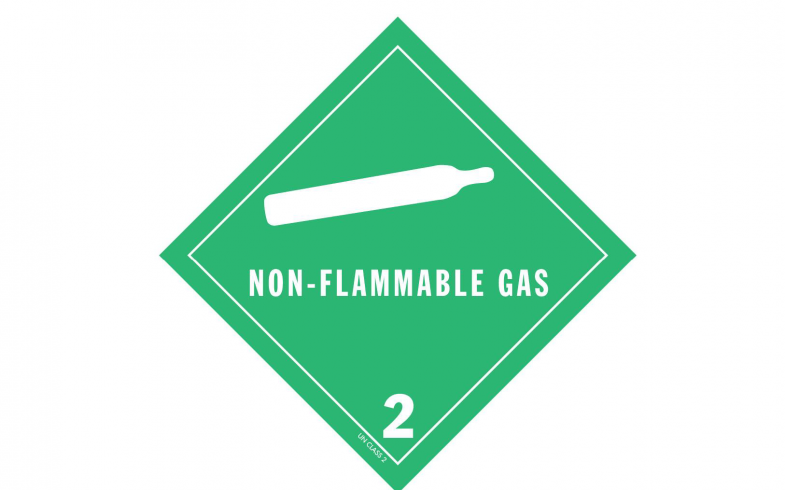| CAS Number: 7440-37-1 |
| UN Number: UN 1006 |
| DOT Shipping Name: Argon, Compressed |
| DOT Classification: 2.2 (Non-Flammable Gas) |
| Label: NON-COMBUSTIBLE, NON-POISONOUS GAS |

Argon is an inert monoatomic gas without color, taste or odor.
Argon got its name from the greek. «αργος» – «lazy”, «indifferent” August 13, 1894, when John William Stratt (Lord Rayleigh) and William Ramsay publicly announced their discovery. However, Argon received official recognition only a quarter of a century later – after the discovery of Helium. After lengthy discussions, Mendeleev and Ramsay came to the conclusion that inert gases should be assigned a separate, so-called zero group between halogens and alkali metals.
The chemical inertness of Argon (like other gases of the zero group) and the monoatomic nature of its molecules are explained primarily by the maximum saturation of the electron shells.
Argon is the lightest of the subgroup of heavy inert gases. It’s 1.38 times heavier than air. It becomes a liquid at -185.9°C, solidifies at -189.4°C (under normal pressure). The main «storage» of terrestrial Argon is the atmosphere: 1.286% (by weight), with 99.6% of atmospheric argon being the heaviest isotope – Argon-40. An even larger fraction of this isotope is found in Argon. For the overwhelming majority of light elements, the picture is the opposite – light isotopes predominate.
In the matter of the Universe, Argon is even more represented than on our planet. It’s especially abundant in hot stars and planetary nebulae. It is estimated that there is more Argon in space than Chlorine, Phosphorus, Calcium, Potassium – elements that are very common on Earth.

Scopes of Argon:
- in argon lasers;
- for filling the inner space of incandescent lamps and double-glazed windows;
- as a protective medium for welding (arc, laser, contact, etc.) of both metals (for example, titanium) and non-metals;
- as a plasma generator in plasmatrons during welding and cutting;
- in the food industry, argon is registered as a food additive E938, as a propellant and packing gas;
- as an extinguishing agent in extinguishing gas installations;
- in medicine, Argon is used in air purification operations and surgical incisions, since it does not form chemical compounds at room temperature;
- in scientific experiments. For example, Argon is used as a constituent part of the atmosphere in the «Mars-500» experiment to reduce oxygen levels to prevent a fire on board a spacecraft during a trip to Mars;
- due to its low thermal conductivity, Argon is used in diving to inflate dry suits, but there are a number of disadvantages, for example, the high price of gas (in addition, a separate system for Argon is needed);
- in chemical synthesis, to create an inert atmosphere when working with compounds that are unstable in air.

INGAS LLC produces Argon of various grades (purity) by the method of low-temperature rectification according to DSTU GOST 10157: 2019 (GOST 10157-2016, IDT) and TU U 24.1-14361569-009: 2010.

| Formula: Ar | ||||
| General Description: monoatomic, non-toxic, chemically inert gas, odorless, colorless and tasteless | ||||
| Atomic (molar) mass: 39.948 g/mol | ||||
| Properties of the chemical element | 0°С (273.15°K, 32℉) & 760 mm Hg (1 atm (physical), 1.033 at (technical), 101.325 кN/м², 101.325 кPа, 14.7 psia, 0 psig, 30 in Hg, 760 torr) | 15°С (288.15°K, 59℉) & 760 mm Hg (1 атм (physical), 1.033 at (technical), 101.325 кN/м², 101.325 кPа, 14.7 psia, 0 psig, 30 in Hg, 760 torr) | 20°С (293.15°K, 68℉) & 760 mm Hg (1 atm (physical), 1.033 at (technical), 101.325 кН/м², 101.325 кPа, 14.7 psia, 0 psig, 30 in Hg, 760 torr) | 15°С (288.15°K, 59℉) & 1 bar (0.987 atm (physical), 1.02 at (technical), 100 кN/м², 100 кPа, 14.5 psia, 0 psig, 29.53 in Hg, 750.062 torr) |
| Density at various temperatures and pressures: | 1.7839 kg/m³ | 1.6911 kg/m³ | 1.6626 kg/m³ | 1.6700 kg/m³ |
| Specific volume at various temperatures and pressures: | 0.5606 m³/kg | 0.5914 m³/kg | 0.6015 m³/kg | 0.5988 m³/kg |

| No | Names of gas and controlled impurities | Formula of an element or chemical compounds | Gas purity and content of its controlled impurities (vol.%, ppmv) | |||
| Brand 4.0 | Brand 4.5 | Brand 5.0 | Brand 6.0 | |||
| 1. | Argon | Ar | 99.993 vol.% | 99.995 vol.% | 99.999 vol.% | 99.9999 vol.% |
| 2. | Nitrogen | N₂ | ⩽50 ppmv | ⩽30 ppmv | ⩽4 ppmv | ⩽0.4 ppmv |
| 3. | Helium | He | – | ⩽2 ppmv | ⩽2 ppmv | ⩽0.2 ppmv |
| 4. | Oxygen | O₂ | ⩽7 ppmv | ⩽10 ppmv | ⩽1 ppmv | ⩽0.1 ppmv |
| 5. | Hydrogen | H₂ | – | ⩽10 ppmv | ⩽1 ppmv | ⩽0.1 ppmv |
| 6. | Amount of hydrocarbons | ΣCₙHₘ | – | ⩽1 ppmv | ⩽1 ppmv | ⩽0.1 ppmv |
| 7. | Carbon dioxide | CO₂ | ⩽5 ppmv | ⩽10 ppmv | ⩽1 ppmv | ⩽0.1 ppmv |
| 8. | Moisture | H₂O | ⩽9 ppmv | ⩽10 ppmv | ⩽1 ppmv | ⩽0.1 ppmv |
